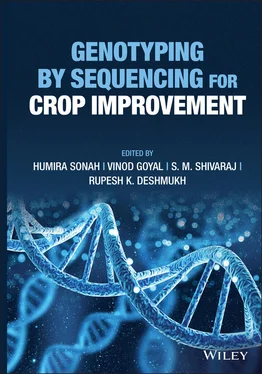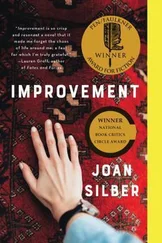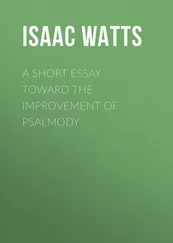Genotyping by Sequencing for Crop Improvement
Здесь есть возможность читать онлайн «Genotyping by Sequencing for Crop Improvement» — ознакомительный отрывок электронной книги совершенно бесплатно, а после прочтения отрывка купить полную версию. В некоторых случаях можно слушать аудио, скачать через торрент в формате fb2 и присутствует краткое содержание. Жанр: unrecognised, на английском языке. Описание произведения, (предисловие) а так же отзывы посетителей доступны на портале библиотеки ЛибКат.
- Название:Genotyping by Sequencing for Crop Improvement
- Автор:
- Жанр:
- Год:неизвестен
- ISBN:нет данных
- Рейтинг книги:4 / 5. Голосов: 1
-
Избранное:Добавить в избранное
- Отзывы:
-
Ваша оценка:
- 80
- 1
- 2
- 3
- 4
- 5
Genotyping by Sequencing for Crop Improvement: краткое содержание, описание и аннотация
Предлагаем к чтению аннотацию, описание, краткое содержание или предисловие (зависит от того, что написал сам автор книги «Genotyping by Sequencing for Crop Improvement»). Если вы не нашли необходимую информацию о книге — напишите в комментариях, мы постараемся отыскать её.
A thoroughly up-to-date exploration of genotyping-by-sequencing technologies and related methods in plant science Genotyping by Sequencing for Crop Improvement,
Genotyping by Sequencing for Crop Improvement
Genotyping by Sequencing for Crop Improvement
Genotyping by Sequencing for Crop Improvement — читать онлайн ознакомительный отрывок
Ниже представлен текст книги, разбитый по страницам. Система сохранения места последней прочитанной страницы, позволяет с удобством читать онлайн бесплатно книгу «Genotyping by Sequencing for Crop Improvement», без необходимости каждый раз заново искать на чём Вы остановились. Поставьте закладку, и сможете в любой момент перейти на страницу, на которой закончили чтение.
Интервал:
Закладка:
34 Hunt, G.J. (1997). Construction of linkage maps with RAPD markers. In: Fingerprinting Methods Based on Arbitrarily Primed PCR (eds. M.R. Micheli and R. Bova). Berlin, Heidelberg: Springer Lab Manuals. Springer https://doi.org/10.1007/978‐3‐642‐60441‐6_22.
35 Hussain, W., Baenziger, P.S., Belamkar, V. et al. (2017). Genotyping‐by‐Sequencing derived high‐density linkage map and its application to QTL mapping of flag leaf traits in bread wheat. Scientific Reports 7: 16394.
36 IRGSP (2005). The map‐based sequence of the rice genome. Nature 436: 793–800. (Suppl. Table 18).
37 Jaccoud, D., Peng, K., Feinstein, D., and Kilian, A. (2001). Diversity arrays: a solid state technology for sequence information independent genotyping. Nucleic Acids Research 29: e25.
38 Jamali, S.H., Cockram, J., and Hickey, L.T. (2019). Insights into deployment of DNA markers in plant variety protection and registration. Theoretical and Applied Genetics 132: 1911–1929.
39 Jena, K.K., Khush, G.S., and Kochert, G. (1992). RFLP analysis of rice introgression lines. Theoretical and Applied Genetics 84: 608–616.
40 Joshi, S.P., Ranjekar, P.K., and Gupta, V.S. (1999). Molecular markers in plant genome analysis. Current Science 77: 230–240.
41 Kagale, S., Koh, C., Clarke, W.E. et al. (2016). Analysis of genotyping by sequencing data. Methods in Molecular Biology 1374: 269–284.
42 Kang, J.‐W., Shin, D., Cho, J.H. et al. (2019). Accelerated development of rice stripe virus‐resistant, near‐isogenic rice lines through marker‐assisted backcrossing. PLoS One 14 (12): e0225974.
43 Kasai, K., Morikawa, Y., Sorri, V.A. et al. (2000). Development of SCAR markers to the PVY resistance gene Ryadg based on a common feature of plant disease resistance genes. Genome 43: 1–8.
44 Kumar, A., Dixit, S., and Henry, A. (2013). Marker‐assisted introgression of major QTLs for grain yield under drought in rice. In: Translational Genomics for Crop Breeding Volume 2: Abiotic Stresses, Yield and Quality (eds. R.K. Varshney and R. Tuberosa). Wiley.
45 Kumar, K., Sarao, P.S., Bhatia, D. et al. (2018). High‐resolution genetic mapping of novel brown planthopper resistance locus, Bph34 in Oryza sativa X Oryza nivara (Sharma & Shastry) derived interspecific F2 population. Theoretical and Applied Genetics 131: 1163–1171.
46 Laucou, V., Haurogne, K., Ellis, N., and Rameau, C. (1998). Genetic mapping in pea. 1. RAPD‐based genetic linkage map of Pisum sativum. Theoretical and Applied Genetics 97: 905–915.
47 Li, H., Vikram, P., Singh, R.P. et al. (2015). A high density GBS map of bread wheat and its application for dissecting complex disease resistance traits. BMC Genomics 16: 216.
48 Litt, M. and Luty, J.M. (1989). A hypervariable microsatellite revealed by in vitro amplification of a dinucleotide repeat within the cardiac muscle actin gene. American Journal of Human Genetics 44: 397–401.
49 Liu, Z., Sun, Q., Ni, Z., and Yang, T. (1999). Development of SCAR markers linked to the Pm21 gene conferring resistance to powdery mildew in common wheat. Plant Breeding 118: 215–219.
50 Lotti, C., Salvi, S., Pasqualone, A. et al. (2000). Integration of AFLP markers into an RFLP‐based map of durum wheat. Plant Breeding 119 (5): 393–401.
51 Makhoul, M., Rambla, C., Voss‐Fels, K.P. et al. (2020). Overcoming polyploidy pitfalls: a user guide for effective SNP conversion into KASP markers in wheat. Theoretical and Applied Genetics 133 (8): 2413–2430.
52 Mardis, E.R. (2008). Next generation DNA sequencing methods. Annual Review of Genomics and Human Genetics 9: 387–402.
53 Matukumalli, L.K., Lawley, C.T., Schnabel, R.D. et al. (2009). Development and characterization of a high density SNP genotyping assay for cattle. PLoS One 4: e5350.
54 McCouch, S.R., Teytelman, L., Xu, Y. et al. (2002). Development and mapping of 2240 new SSR markers for rice (Oryza sativa L.). DNA Research 9: 199–207.
55 McCouch, S.R., Zhao, K., Wright, M. et al. (2010). Development of genome‐wide SNP assays for rice. Breeding Science 60: 524–535.
56 McCouch, S.R., Wright, M.H., Tung, C.‐W. et al. (2015). Open access resources for genome‐wide association mapping in rice. Nature Communications 7: 10532.
57 Melchinger, A.E., Messemer, M.M., Lee, M. et al. (1991). Diversity and relationship among US maize inbreds revealed by RFLPs. Crop Science 31: 669–678.
58 Milbourne, D., Meyer, R.C., Collins, A.J. et al. (1998). Isolation, characterization and mapping of simple sequence repeat loci in potato. Molecular & General Genetics 259: 233–245.
59 Mir, R.R., Hiremath, P.J., Lizarazu‐Riera, O., and Varshney, R.K. (2013). Evolving molecular marker technologies in plants: from RFLPs to GBS. In: Diagnostics in Plant Breeding, https://doi.org/10.1007/978‐94‐007‐5687‐8__11(eds. T. Lübberstedt and R.K. Varshney). Dordrecht: Springer Science Business Media.
60 Mullis, K., Faloona, F., Scharf, S. et al. (1986). Specific enzymatic amplication of DNA in vitro: the polymerase chain reaction. Cold Spring Harbor Symposium on Quantitative Biology. 51: 263–273.
61 Nguyen, K.L., Grondin, A., Courtois, B., and Gantet, P. (2019). Next‐Generation sequencing accelerates crop genome discovery. Trends in Plant Science 24: 263–274.
62 Olsen, M., Hood, L., Cantor, C., and Botstein, D. (1989). A common language for physical mapping of the human genome. Science 245: 1434–1435.
63 Orjuela, J., Garavito, A., Bouniol, M. et al. (2010). A universal core genetic map for rice. Theoretical and Applied Genetics 120: 563–572.
64 Parasnis, A.S., Ramakrishna, W., Chowdari, K.V. et al. (1999). Microsatellite (GATA)n reveals sex‐specific differences in papaya. Theoretical and Applied Genetics 99: 1047–1052.
65 Paterson, A.H., Tanksley, S.D., and Sorrels, M.E. (1991). DNA markers in crop improvement. Advances in Agronomy 46: 39–90.
66 Paull, J.G., Chalmers, K.J., Karakousis, A. et al. (1998). Genetic diversity in Australian wheat varieties and breeding material based on RFLP data. Theoretical and Applied Genetics 96: 435–446.
67 Poland, J. and Rife, T.W. (2012). Genotyping‐by‐sequencing for plant breeding and genetics. Plant Genitics 5: 92–102.
68 Poland, J.A., Brown, P.J., Sorrells, M.E., and Jannink, J.‐L. (2012). Development of high‐density genetic maps for barley and wheat using a novel two‐enzyme genotyping‐by‐sequencing approach. PLoS One 7 (2): e32253.
69 Puritz, J.B., Hollenbeck, C.M., and Gold, J.R. (2014). dDocent: a RADseq, variant‐calling pipeline designed for population genomics of non‐model organisms. Peer Journal 2: e431.
70 Qi, L., Echalier, B., Friebe, B., and Gill, B.S. (2003). Molecular characterization of a set of wheat deletion stocks for use in chromosome bin mapping of ESTs. Functional & Integrative Genomics 3: 39–55. https://doi.org/10.1007/s10142‐002‐0063‐5.
71 Ramos, A.M., Crooijmans, R.P.M.A., Affara, N.A. et al. (2009). Design of a high density SNP genotyping assay in the pig using SNPs identified and characterized by next generation sequencing technology. PLoS One 4: e6524.
72 Richard, I. and Beckman, J.S. (1995). How neutral are synonymous codon mutations? Nature Genetics 10: 259.
73 Roder, M.S., Korzun, V., Wendehake, K. et al. (1998). A microsatellite map of wheat. Genetics 149: 2007–2023.
74 Rosas, J.E., Bonnecarrère, V., and Pérez de Vida, V.F. (2014). One‐step, codominant detection of imidazolinone resistance mutations in weedy rice (Oryza sativa L.). Electronic Journal of Biotechnology 17: 95–101.
75 Sachidanandam, R., Weissman, D., Schmidt, S.C. et al. (2001). A map of human genome sequence variation containing 1.42 million single nucleotide polymorphisms. Nature 409 (6822): 928–933.
76 Sanger, F., Nicklen, S., and Coulson, A.R. (1977). DNA sequencing with chain chain‐terminating inhibitors. Proceedings of the National Academy Sciences of the United States of America 74: 5463–5467.
Читать дальшеИнтервал:
Закладка:
Похожие книги на «Genotyping by Sequencing for Crop Improvement»
Представляем Вашему вниманию похожие книги на «Genotyping by Sequencing for Crop Improvement» списком для выбора. Мы отобрали схожую по названию и смыслу литературу в надежде предоставить читателям больше вариантов отыскать новые, интересные, ещё непрочитанные произведения.
Обсуждение, отзывы о книге «Genotyping by Sequencing for Crop Improvement» и просто собственные мнения читателей. Оставьте ваши комментарии, напишите, что Вы думаете о произведении, его смысле или главных героях. Укажите что конкретно понравилось, а что нет, и почему Вы так считаете.












